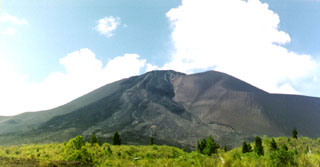Report on Soputan (Indonesia) — 26 September-2 October 2018
Smithsonian Institution / US Geological Survey
Weekly Volcanic Activity Report, 26 September-2 October 2018
Managing Editor: Sally Sennert.
Please cite this report as:
Global Volcanism Program, 2018. Report on Soputan (Indonesia) (Sennert, S, ed.). Weekly Volcanic Activity Report, 26 September-2 October 2018. Smithsonian Institution and US Geological Survey.
Soputan
Indonesia
1.112°N, 124.737°E; summit elev. 1785 m
All times are local (unless otherwise noted)
PVMBG reported that increased seismicity at Soputan was notable on 2 October, characterized by an increased number of signals indicating emissions and avalanches (which began in September and mid-July, respectively), increased RSAM values, and a higher number of volcanic earthquakes (since September). Data from a thermal camera showed increased summit temperatures, indicating the presence of lava. The Alert Level was increased to 3 (on a scale of 1-4) on 3 October; residents and tourists were advised not to approach the craters within a radius of 4 km, with an additional expansion to 6.5 km in WSW direction due to increased risk from a breach in the crater rim. An eruption commenced at 0847 on 3 October, producing a dense ash plume that rose 4 km above the summit and drifted W and NW. Based on seismic data the event lasted six minutes. Events at 1044, 1112, and 1152 produced ash plumes that rose 2 km, 2.5 km , and 5 km above the crater rim, respectively. A thermal anomaly identified in satellite data significantly increased, and incandescent ejecta at the summit was clearly observed by residents. Avalanches of material traveled 2.5 km down the NE flank.
Geological Summary. The Soputan stratovolcano on the southern rim of the Quaternary Tondano caldera on the northern arm of Sulawesi Island is one of Sulawesi's most active volcanoes. The youthful, largely unvegetated volcano is the only active cone in the Sempu-Soputan volcanic complex, which includes the Soputan caldera, Rindengan, and Manimporok (3.5 km ESE). Kawah Masem maar was formed in the W part of the caldera and contains a crater lake; sulfur has been extracted from fumarolic areas in the maar since 1938. Recent eruptions have originated at both the summit crater and Aeseput, a prominent NE-flank vent that formed in 1906 and was the source of intermittent major lava flows until 1924.
Sources: Pusat Vulkanologi dan Mitigasi Bencana Geologi (PVMBG, also known as CVGHM), Badan Nacional Penanggulangan Bencana (BNPB)

